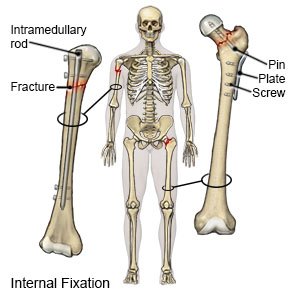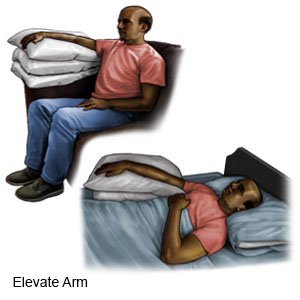ORIF of an Elbow Fracture
Medically reviewed by Drugs.com. Last updated on Jun 5, 2024.
AMBULATORY CARE:
What you need to know about open reduction and internal fixation (ORIF) of an elbow fracture:
ORIF is surgery to fix a broken elbow. Open reduction means the bones are moved back into the correct position. Internal fixation means plates, screws, pins, or wires will be used to hold the bones in place while they heal.
 |
How to prepare for ORIF:
- Your surgeon will tell you how to prepare. He or she may tell you not to eat or drink anything after midnight on the day of surgery. Arrange to have someone drive you home from surgery.
- Tell your surgeon about all medicines you currently take. He or she will tell you if you need to stop any medicine for surgery, and when to stop. He or she will tell you which medicines to take or not take on the day of surgery.
- Tell your surgeon about all your allergies. Tell him or her if you had an allergic reaction to anesthesia or antibiotics.
- You may need blood or urine tests. You may also need elbow x-rays.
What will happen during ORIF:
You may be given general anesthesia to keep you asleep and free from pain during surgery. You may instead be given regional anesthesia to numb the area. You will be awake with regional anesthesia, but you should not feel pain. An incision will be made on or around your elbow fracture. Your surgeon will move the bones back into the correct position. He or she may use plates, screws, pins, or wires to hold the broken pieces together. Damaged blood vessels and nerves will also be fixed. X-rays may be taken to see if the bones are in the correct position. The wound will be closed with stitches or medical tape and covered with bandages.
What to expect after ORIF:
You will be taken to a room to rest until you are fully awake. Healthcare providers will monitor you closely for any problems. Do not get out of bed until your healthcare provider says it is okay. When healthcare providers see that you are okay, you may be able to go home.
- A cast or splint may be placed to help prevent movement so your bones can heal.
- Medicines may be given to prevent or relieve pain or nausea.
Risks of ORIF for an elbow fracture:
Nerves, ligaments, and muscles may be damaged during surgery. Your arm, hand, or fingers may become stiff, numb, or weak. Your elbow may not heal properly. You may not be able to move your elbow the way you did before the injury. You may have trouble going back to your usual activities.
Call your local emergency number (911 in the US) if:
- You suddenly feel lightheaded and short of breath.
- You have chest pain when you take a deep breath or cough.
- You cough up blood.
Seek care immediately if:
- Your arm or leg feels warm, tender, and painful. It may look swollen and red.
- Blood soaks through your bandage.
- You have numbness or weakness in your arm or fingers.
- Your fingers look pale or blue, or they tingle.
- Your cast, splint, or brace breaks or gets damaged.
- Your stitches or staples come apart.
- You have more swelling in your fingers.
Call your doctor or surgeon if:
- Your cast feels too tight.
- You have a fever.
- You have chills, a cough, or feel weak and achy.
- Your cast gets wet.
- Your cast, splint, or brace begins to smell.
- Your wound is red, swollen, or draining pus.
- Your pain does not get better, even after you take pain medicine.
- You have questions or concerns about your condition or care.
Medicines:
- Prescription pain medicine may be given. Ask your healthcare provider how to take this medicine safely. Some prescription pain medicines contain acetaminophen. Do not take other medicines that contain acetaminophen without talking to your healthcare provider. Too much acetaminophen may cause liver damage. Prescription pain medicine may cause constipation. Ask your healthcare provider how to prevent or treat constipation.
- Take your medicine as directed. Contact your healthcare provider if you think your medicine is not helping or if you have side effects. Tell your provider if you are allergic to any medicine. Keep a list of the medicines, vitamins, and herbs you take. Include the amounts, and when and why you take them. Bring the list or the pill bottles to follow-up visits. Carry your medicine list with you in case of an emergency.
Self-care:
- Limit activity. Ask your healthcare provider about the best activities for you. You not be able to lift heavy weights or play sports until your healthcare provider says it is okay. Ask when you can start to drive again and return to work.
- Apply ice as directed. Ice helps decrease swelling and pain. Ice may also help prevent tissue damage. Use an ice pack, or put crushed ice in a plastic bag. Cover it with a towel and place it on the area for 15 to 20 minutes every hour or as directed.
- Elevate your elbow. Keep the elbow above the level of your heart as often as you can. This will help relieve pain and swelling. Prop your arm on pillows to keep it elevated comfortably.

- Ask when you can bathe. When you are allowed to bathe, cover the cast with 2 plastic bags. Tape the bags to your skin to keep the water out. Keep the cast out of the water so it does not get wet. If you do not have a cast, carefully wash the wound with soap and water. Dry the area and put on new, clean bandages as directed. Change the bandages when they get wet or dirty.
Cast, splint, or brace care:
- Check the skin around the cast, splint, or brace each day. Apply lotion on any red or sore areas.
- Do not push down or lean on any part of the cast, splint, or brace.
- Do not scratch the skin under the cast, splint, or brace with any sharp or pointed object.
- Move your fingers several times a day. This will help decrease stiffness and swelling.
Go to physical therapy, if directed:
A physical therapist can teach you exercises to help improve movement and decrease pain. Physical therapy can also help improve strength and decrease your risk for loss of function.
Follow up with your doctor or surgeon as directed:
You will need to return to have the surgery wound checked and stitches or cast removed. You may be given an elbow brace that allows more movement. This will help prevent elbow stiffness. Write down your questions so you remember to ask them during your visits.
© Copyright Merative 2024 Information is for End User's use only and may not be sold, redistributed or otherwise used for commercial purposes.
The above information is an educational aid only. It is not intended as medical advice for individual conditions or treatments. Talk to your doctor, nurse or pharmacist before following any medical regimen to see if it is safe and effective for you.
Further information
Always consult your healthcare provider to ensure the information displayed on this page applies to your personal circumstances.
